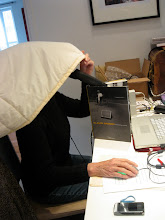Follow @janetrobbins14
Parisians love the theatre! In the Metro, whole sections of wall space are given to promoting plays. In the weekly L'Officiel des Spectacles, theatre listings take up over 50 pages each week. Comedies, tragedies, dramas, musicals, festivals - I can't think of any form of live theatre that you will not find here.
And theatres are everywhere. In our neighborhood alone, there must be at least six small ones, with maybe seating for a hundred. And that's before you get a few blocks away to the Grands Boulevards, where there are several very large ones. It's the same in every arrondissement.
This year, Matthew and I have been making an effort to become theatre patrons, and are finding it a pure delight!
We learned right away that it is essential to READ the play first -- in French! Actors speak quickly on stage, often in some kind of character-driven voice, so if you don't know the text ahead of time, you soon find yourself lost.
So far, we've seen plays translated into French from English playwrights -- Ronald Harwood, Alan Ayckburn, and, coming up next week, Oscar Wilde -- but this past Sunday we dipped ourselves into a classic French play by Eugène Labiche, Le Prix Martin, at the historic Théâtre Odéon over in the 6th arrondissement, next to the Luxembourg Gardens.
One of the earliest productions was Beaumarchais' The Marriage of Figaro. The Odéon was reconstructed in 1808, then burned to the ground in 1818!
The present building was designed by Pierre Thomas Baraguay, and opened its doors in 1819.
Although it's still known as the Théâtre Odéon, since 1990 its official name is "Odéon Théâtre de l'Europe". It is one of six national theatres of France. In 2006, it underwent a glorious restoration/renovation, all of which was on full display on Sunday.
The upstairs lobby, with its elegant columns and gleaming chandeliers awaited the sold-out audience...
...whilst the figure of tragedy stood proudly across from her counterpart, which you can see reflected behind her in the mirror...
...and striking oil portraits gave a small clue to the history of the important plays and stage directors that have appeared here over the past 230 plus years. In 1827, it became the first theatre in France to present Shakespeare plays in English.
Nothing quite prepared us, though, for the actual theatre itself, which was very dimly lit, so hard to photograph, but which was aglow in red velvet and gilt railings, rising up five levels, and capped by this dazzling ceiling:
Sunday's play, Le Prix Martin, was almost the last work of Eugène Labiche, one of France's most popular comic playwrights of the 19th century. A classic French farce with all kinds of plot twists, romantic intrigues, high drama, gunshots, broad humor -- in essence, a not so gentle nudge at the manners and mores of the Bourgeousie. Flaubert was said to have adored it!
As well as discovering the joys of live theatre, we've also been finding some rare treasures in the world of cinema. Our nearest movie house is at the Forum des Halles, where there are probably some 20 screens playing moves all the time. Even though part of the subterranean rat maze that is Forum des Halles, it's very close and we can walk there, so we tend to take advantage of its location. However, there are a few others that are worth a metro ride, and this is one: La Pagode, over in a quiet backwater of the 7th arrondissement.
The story of this place reads like a fairy tale: Once upon a time, in 1895, a Monsieur Morin, the director of the very fancy department store, Le Bon Marché, wanted to give his wife an especially beautiful birthday present. At the time, the Japanese and Chinese markets had opened up to the west, and everyone was wild for the oriental style.
So M. Morin commissioned the architect Alexandre Marcel to build a pagoda on the rue Babylone for his wife, complete with a small garden and stone Chinese lions.
The delicate stained-glass windows and ornate woodwork are just stunning. Alas, Madame Morin, although she adored the pagoda, did not adore her husband. She left him the next year for his business partner, M. Plassard! However, she continued to host sumptuous soirées here, attended by the cream of Paris society, until 1927, when it was closed.
That might have been the end for La Pagode, but in 1930, it opened its doors again as a cinema!
The elegant salon, with its decorated walls and ceiling, now houses plush red seats and a good-sized screen. It made its reputation as a venue for avant-garde and independent films -- especially in the 1950s and 1960s, but it's not all been plain sailing. At one point it was threatened with demolition. Happily, it is now a protected building, there is a second screen downstairs, and patrons come from near and far to support its programs. When the weather's nice, you can take a coffee in the garden, and give thanks to M. Morin for building such a beautiful spot, even though it ended up breaking his heart.
It is, finally, "April in Paris"
À bientôt!

























































-Dior+(late+40s).jpg)
.jpg)


+Marcelle+Dormoy+(1948).jpg)



